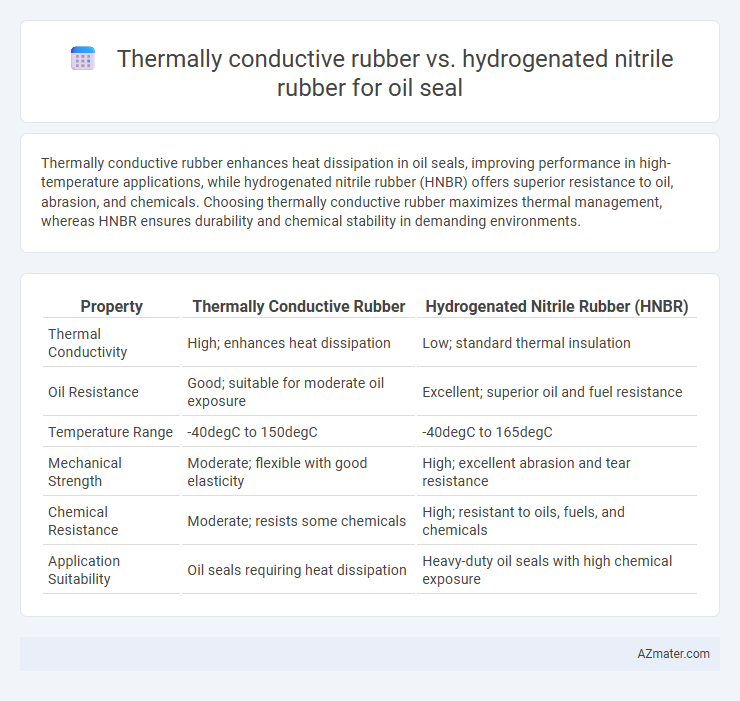Thermally conductive rubber enhances heat dissipation in oil seals, improving performance in high-temperature applications, while hydrogenated nitrile rubber (HNBR) offers superior resistance to oil, abrasion, and chemicals. Choosing thermally conductive rubber maximizes thermal management, whereas HNBR ensures durability and chemical stability in demanding environments.
Table of Comparison
| Property | Thermally Conductive Rubber | Hydrogenated Nitrile Rubber (HNBR) |
|---|---|---|
| Thermal Conductivity | High; enhances heat dissipation | Low; standard thermal insulation |
| Oil Resistance | Good; suitable for moderate oil exposure | Excellent; superior oil and fuel resistance |
| Temperature Range | -40degC to 150degC | -40degC to 165degC |
| Mechanical Strength | Moderate; flexible with good elasticity | High; excellent abrasion and tear resistance |
| Chemical Resistance | Moderate; resists some chemicals | High; resistant to oils, fuels, and chemicals |
| Application Suitability | Oil seals requiring heat dissipation | Heavy-duty oil seals with high chemical exposure |
Introduction to Oil Seal Materials
Thermally conductive rubber and hydrogenated nitrile rubber (HNBR) are essential materials used in oil seals, each offering unique properties suited for specific applications. Thermally conductive rubber enhances heat dissipation, improving seal performance in high-temperature environments, while hydrogenated nitrile rubber provides excellent resistance to oils, fuels, and chemicals with superior mechanical strength and aging resistance. Selecting the appropriate material depends on operational requirements such as temperature range, chemical exposure, and durability, making both materials critical for reliable oil seal performance in automotive and industrial machinery.
Overview of Thermally Conductive Rubber
Thermally conductive rubber (TCR) exhibits superior heat dissipation properties compared to traditional elastomers, making it ideal for oil seals in high-temperature environments. Unlike hydrogenated nitrile rubber (HNBR), which offers excellent oil and chemical resistance, TCR enhances thermal management by efficiently transferring heat away from the seal interface, reducing wear and extending seal life. This combination of thermal conductivity and mechanical flexibility positions TCR as a crucial material for applications requiring both sealing performance and temperature control.
Properties of Hydrogenated Nitrile Rubber (HNBR)
Hydrogenated nitrile rubber (HNBR) exhibits superior oil resistance, excellent thermal stability up to 150degC, and strong mechanical properties, making it highly suitable for oil seal applications in harsh environments. HNBR maintains flexibility and compression set resistance even after prolonged exposure to heat, oil, and chemicals, outperforming thermally conductive rubber in durability and chemical compatibility. Its resistance to abrasion and swelling ensures reliable sealing performance in automotive and industrial oil sealing systems.
Thermal Conductivity: Key Differences
Thermally conductive rubber exhibits significantly higher thermal conductivity, typically ranging from 1 to 5 W/m*K, compared to hydrogenated nitrile rubber (HNBR) which generally has thermal conductivity around 0.2 W/m*K, making it more effective in dissipating heat in oil seal applications. HNBR provides superior chemical resistance, oil resistance, and mechanical strength but is less efficient in managing thermal load due to its lower thermal conductivity properties. Selecting thermally conductive rubber improves heat transfer and temperature regulation, crucial for maintaining oil seal integrity in high-temperature and high-friction environments.
Chemical Resistance in Oil Seals
Thermally conductive rubber offers enhanced heat dissipation but generally exhibits lower chemical resistance compared to hydrogenated nitrile rubber (HNBR), which is renowned for its robust resistance to oils, fuels, and various hydrocarbons in oil seals. HNBR maintains structural integrity and swelling resistance under extended exposure to aggressive petroleum-based fluids, ensuring reliable sealing performance in harsh environments. Selecting hydrogenated nitrile rubber for oil seals provides superior chemical resistance, critical for applications involving high-temperature oil and chemical exposure.
Mechanical Performance Comparison
Thermally conductive rubber offers superior heat dissipation and enhanced mechanical strength, making it ideal for oil seals operating under high thermal stress. Hydrogenated nitrile rubber (HNBR) excels in chemical resistance, abrasion resistance, and maintaining elasticity at extreme temperatures but typically has lower thermal conductivity compared to thermally conductive formulations. When comparing mechanical performance, thermally conductive rubber provides better thermal stability and wear resistance, whereas HNBR delivers excellent tensile strength and resistance to oil and fuel exposure, crucial for long-lasting oil seal applications.
Temperature Stability and Performance
Thermally conductive rubber offers superior temperature stability, maintaining performance in high-heat environments up to 200degC, making it ideal for oil seals exposed to severe thermal conditions. Hydrogenated nitrile rubber (HNBR) provides excellent chemical resistance and durability with operational temperatures typically ranging from -40degC to 150degC, ensuring reliable sealing performance in harsh oil and fuel applications. For oil seals requiring enhanced heat dissipation and long-term stability under elevated temperatures, thermally conductive rubber outperforms HNBR in thermal management and mechanical resilience.
Durability and Service Life
Thermally conductive rubber offers superior heat dissipation, which significantly enhances the durability and service life of oil seals by reducing thermal degradation and preventing premature failure. Hydrogenated nitrile rubber (HNBR) provides excellent resistance to oils, chemicals, and high temperatures, ensuring strong mechanical properties and extended lifespan under harsh operating conditions. Comparing both, thermally conductive rubber excels in heat management, while HNBR is favored for chemical resilience, making the choice dependent on the specific environmental stresses impacting oil seal performance.
Cost Implications and Availability
Thermally conductive rubber typically incurs higher costs due to specialized fillers and manufacturing processes, which can impact overall oil seal production expenses. Hydrogenated nitrile rubber (HNBR) offers a more cost-effective solution with widespread availability and proven chemical resistance in oil seal applications. Availability of HNBR in large volumes ensures steady supply chains, whereas thermally conductive rubber materials may face limited suppliers and lead to procurement delays.
Application Suitability and Recommendations
Thermally conductive rubber offers enhanced heat dissipation, making it ideal for oil seals in high-temperature environments such as automotive engines and industrial machinery requiring efficient thermal management. Hydrogenated nitrile rubber (HNBR) excels in chemical resistance and mechanical durability, providing superior performance in harsh oil and fuel exposures commonly found in heavy-duty sealing applications. For applications prioritizing thermal conductivity and heat control, thermally conductive rubber is recommended, while HNBR is better suited for sealing scenarios demanding outstanding resistance to oil, heat, and abrasion.

Infographic: Thermally conductive rubber vs Hydrogenated nitrile rubber for Oil seal
 azmater.com
azmater.com